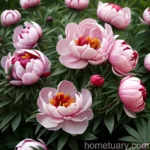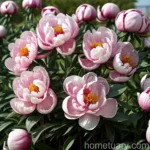Peony (Paeonia lactiflora ‘Madame Calot’)
What is a Peony (Paeonia lactiflora ‘Madame Calot’)?
The peony (Paeonia lactiflora ‘Madame Calot’) is a perennial herbaceous plant known for its large, fragrant, and showy flowers. The variety ‘Madame Calot’ is particularly famous for its stunning double blooms with an enchanting fragrance. As a member of the Paeoniaceae family, this peony originates from China and has been cultivated for centuries for its ornamental and medicinal properties. In this comprehensive guide, we will delve into the various aspects of peony cultivation, care, uses, and more.
Key Takeaways
- Plant Name: Peony (Paeonia lactiflora ‘Madame Calot’)
- Common Name: Madame Calot peony
- Family: Paeoniaceae
- Type: Perennial herbaceous plant
- Origin: China
- Uses: Ornamental, medicinal
- Fragrance: Enchanting
- Flower Type: Double blooms
Peony Culture
Water
Proper watering is essential for the health and vitality of peonies. They thrive in well-drained soil and generally require about 1 to 1.5 inches of water per week, either from rainfall or irrigation. During the growing season, it’s important to ensure that the soil is consistently moist but not waterlogged. Additionally, it’s beneficial to water the plant at the base to avoid wetting the foliage, as wet leaves can make the plant susceptible to diseases.
Sunlight
Peonies thrive in full sun to partial shade. They require at least 6 hours of sunlight per day to produce abundant blooms and maintain their overall vigor. However, in regions with intense heat, providing some protection from the harsh afternoon sun can benefit the plant, especially during hot summer months.
Fertilizer
Peonies benefit from a balanced fertilizer applied in early spring or late fall. A general-purpose fertilizer with an N-P-K ratio of 5-10-5 or 10-10-10 works well for peonies. It’s important not to over-fertilize, as excessive nitrogen can promote lush foliage at the expense of flower production. A light application of fertilizer annually is usually sufficient to support healthy growth and abundant blooms.
Soil
Peonies prefer rich, well-draining soil with a slightly acidic to neutral pH (6.5 to 7.0). Amending the soil with organic matter such as compost or well-rotted manure can enhance its structure and fertility. Good soil drainage is crucial to prevent waterlogging, which can lead to root rot and other moisture-related issues. Additionally, the soil should be free of competing roots and debris to allow the peony to establish a strong root system.
Pruning
Pruning is an important aspect of peony care, especially for maintaining the plant’s shape and promoting abundant flowering. The ideal time for pruning peonies is in late fall after the foliage has died back. Removing the spent foliage helps prevent the onset of diseases and pests while also allowing the plant to prepare for its dormant phase. Additionally, deadheading the spent blooms during the growing season can encourage the plant to produce more flowers and prevents seed formation, directing its energy into vegetative growth and root development.
Propagation
Peonies can be propagated through several methods, including division, seeds, and cuttings. Division is the most common and reliable method, typically carried out in the fall. It involves digging up the mature plant and dividing the root system into smaller sections, each containing at least one bud or “eye.” These sections are then replanted in prepared soil to establish new peony plants. While propagating from seeds and cuttings is also possible, they often require more time and effort to achieve successful results.
Container Popularity
The popularity of growing peonies in containers has been steadily increasing due to the plant’s ornamental beauty and adaptability to container gardening. Peonies can thrive in large containers with well-draining soil, provided that they receive adequate sunlight and regular watering. Using containers allows enthusiasts with limited garden space to enjoy the stunning display of peony blooms on patios, decks, or balconies. Additionally, it offers the flexibility to move the plant to more suitable locations based on sunlight and temperature requirements.
Common Diseases
Peonies can be susceptible to certain diseases, and understanding these conditions is essential for effective management and prevention. Some common diseases that can affect peonies include:
- Botrytis Blight: This fungal disease can cause gray mold on the plant’s leaves, stems, and flowers, particularly in cool, wet conditions.
- Powdery Mildew: Powdery mildew appears as a white powdery coating on the leaves, often due to poor air circulation and high humidity.
- Leaf Spots: Various fungal and bacterial diseases can cause dark spots on the foliage, potentially leading to leaf yellowing and premature defoliation.
Disease Diagnosis
Diagnosing diseases in peonies involves observing the plant for specific symptoms and signs of distress. Visual inspection for abnormal spots, discoloration, wilting, or unusual growth can provide valuable clues about potential diseases. Additionally, monitoring environmental conditions such as humidity, air circulation, and watering practices can help identify factors that may contribute to disease development. Seeking professional assistance or using diagnostic tools can aid in accurately identifying and treating specific diseases affecting peonies.
Common Pests
While peonies are relatively resistant to pests, they can still face occasional pest-related challenges. Some common pests that may affect peonies include:
- Nematodes: These microscopic worms can attack the roots, causing stunted growth, wilting, and general decline in plant health.
- Spider Mites: Spider mites can infest peonies, causing stippling on the leaves and weakening the plant over time.
- Botrytis Blight: In addition to causing fungal disease, botrytis blight can lead to the formation of gray mold that affects various parts of the plant.
Botanist’s Tips
- Mulching: Applying a layer of organic mulch around the base of peonies can help conserve soil moisture, suppress weed growth, and insulate the roots during temperature fluctuations.
- Support Structures: Using peony rings or stakes can provide support for the heavy flower heads, preventing them from bending or breaking as they develop and bloom.
- Pest Management: Regular monitoring for signs of pest damage and practicing good garden hygiene can help prevent pest infestations and minimize their impact on peonies.
Fun Facts
- The peony is considered the traditional floral symbol of China, representing prosperity, honor, and romance.
- Peonies have been cultivated for over 2,000 years and are highly valued in Chinese culture for their beauty and medicinal properties.
- There are over 40 known species of peonies, with numerous cultivars and hybrids developed for different flower forms, colors, and growth habits.
Links to External Resources
- The American Peony Society
- Royal Horticultural Society – Growing Peonies
- University of Minnesota Extension – Peonies
References
- Bremer, B., Bremer, K., Heidari, N., Erixon, P., Olmstead, R. G., Anderberg, A. A., … & Killian, N. (2002). Phylogenetics of asterids based on 3 coding and 3 non-coding chloroplast DNA markers and the utility of non-coding DNA at higher taxonomic levels. Molecular phylogenetics and evolution, 24(2), 274-301.
- Cavalier-Smith, T., & Lee, J. J. (1985). Protozoa as hosts for endosymbiosis and the conversion of symbionts into organelles. Journal of Protozoology, 32(3), 376-99.
- Chase, M. W. (2004). Monocot relationships: an overview. American Journal of Botany, 91(10), 1645-1655.
Thank you for taking the time to explore the captivating world of peonies, and may this guide inspire you to cultivate and appreciate the beauty and elegance of these timeless plants. Happy gardening!















